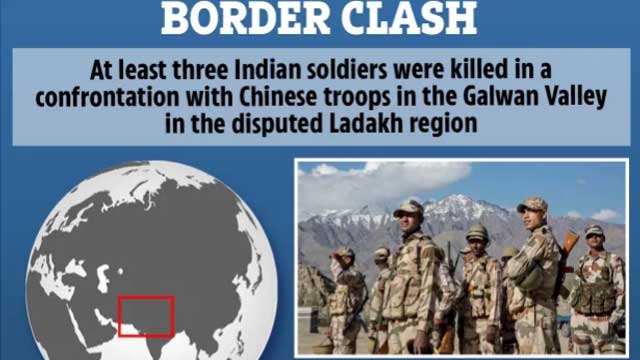India says three of its soldiers, including a senior army officer, have been killed in a “violent face-off” at the border with China.
There was no immediate confirmation of deaths among the Chinese forces, but an official Indian army statement said there had been “casualties on both sides”.
The incident occurred on Monday night in the Galwan valley of Kashmir, where the two countries have been engaged in a tense standoff for a number of weeks.
It is believed to be the first deadly incident on the disputed India-China border, known as the Line of Actual Control (LAC), since a 1975 incident in Arunachal Pradesh.
China accused Indian forces of repeatedly crossing the border and launching “provocative attacks on Chinese personnel”.
Zhao Lijian, a foreign office spokesperson in Beijing, would not comment on Chinese casualties. He said China had strongly protested the incident but remained committed to “peace and tranquility” between the two nuclear-armed neighbours.
“But what is shocking is that on 15 June, the Indian troops seriously violated the consensus of the two sides, crossed the border illegally twice and carried out provocative attacks on Chinese personnel, resulting in serious physical conflicts between the two border forces,” Zhao said.
Senior officers from both countries had already begun meeting on Tuesday when the news of the deadly clash was released by the Indian army, which said it hoped to defuse the situation. The Global Times, the English-language arm of the Chinese state newspaper People’s Daily, quoted the Chinese foreign ministry as saying both sides “agreed to resolve the bilateral issues through dialogue to ease the border situation and maintain peace and tranquillity in border areas”.
The exact nature of the “face-off” remains unclear, but there doesn’t appear to be any suggestion from officials that shots were fired, unlike in the 1975 incident.
Two Indian security officials in Kashmir, speaking to the Associated Press on condition of anonymity, insisted that neither side used guns and that the two sides engaged in fist-fighting and stone-throwing, which led to the deaths. Soldiers along the border routinely patrol without weapons, in order to reduce the risk of any escalation.
Tensions between the two neighbouring Asian giants are at their worst since the 2017 Doklam crisis, where both sides ramped up military deployments at their respective borders with Bhutan.
This time, the crisis is centred on the disputed Kashmir region, and began on 5 May when Indian officials say Chinese soldiers crossed over into Indian territory at three points, erecting tents and guard posts. Defence analysts believe China gained around 60 sq km of land at this time.
For its part, China has repeatedly objected to the construction of a strategic road on the Indian side, linking the region to an airstrip close to China.
After that initial clash, which saw insults shouted and both sides ordering each other to leave in scenes that made it onto TV news, both countries have flooded the region with thousands more troops and new military hardware.
Chinese and Indian soldiers have physically come to blows on several occasions, sometimes seriously injuring each other, in displays that have been followed each time by a round of talks between high-ranking officers.
Brahma Chellaney, professor of strategic studies at the Delhi-based Centre for Policy Research, told The Independent that the clashes in recent weeks were “more than fistfights”. “About 40 days ago, violent clashes occurred in Ladakh and on the Sikkim-Tibet border. Improvised weapons other than firearms were employed then and in last night’s confrontation,” he said.
He blamed China’s initial “stealth encroachments” for starting the current standoff, and said that “as long as the Chinese forces do not retreat, the risks of further clashes or a wider conflict are high”.
China, Chellaney said, “miscalculated by believing that it could pull off a cost-free aggression”. “India is unlikely to put up with China’s aggression, and a protracted military standoff extending across virtually the entire Himalayan frontier cannot be discounted.”
India and China already fought one war over the border, which spans nearly 3,500km, in 1962. The two countries have been trying to settle their border dispute since the early 1990s, without success.
India’s prime minister Narendra Modi did not immediately address the border incident on his official social media accounts on Tuesday, and he pushed ahead with a virtual conference attended by chief ministers of all the country’s states to discuss the national fight against coronavirus. Defence minister Rajnath Singh also attended, having discussed the China situation at a separate meeting in the morning with his joint chiefs of staff.-The Independent





